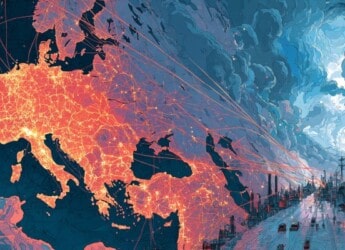|
|
Content Assessment: A Changing Narrative? Ukraine Conflict Assessments in Maps (August 13 - 17, 2022)
Information - 92%
Insight - 93%
Relevance - 91%
Objectivity - 92%
Authority - 93%
92%
Excellent
A short percentage-based assessment of the qualitative benefit of the post highlighting the recent Ukraine conflict assessments in maps from the Institute for the Study of War.
Editor’s Note: One of the most accurate and detailed sources for ongoing updates on the Ukraine crisis is the Ukraine Conflict Update from the Institute for the Study of War. The Institute for the Study of War (ISW) is a 501(c)(3) organization and produces strictly non-partisan, non-ideological, fact-based research. ISW seeks to promote an informed understanding of war and military affairs through comprehensive, independent, and accessible open-source research and analysis. ISW’s research is made available to the general public, military practitioners, policymakers, and media members. Providing a daily synthesis of key events related to the Russian aggression against Ukraine, ISW updates may benefit cybersecurity, information governance, and legal discovery professionals as they follow the business, information technology, and legal trends and trajectories impacted by and stemming from the current Ukraine conflict.
Assessment and Maps*
Ukraine Conflict Assessments – An Overview in Maps
- Institute for the Study of War (ISW), Russia Team
- Critical Threats Project (CTP), American Enterprise Institute
General Assessment Background Info
- ISW systematically publishes Russian campaign assessments that include maps highlighting the assessed control of terrain in Ukraine and main Russian maneuver axes.
- These maps augment daily synthetic products that cover key events related to renewed Russian aggression against Ukraine.
The Russian Offensive Campaign Assessments
- August 17, 2022
- By Karolina Hird, Kateryna Stepanenko, Angela Howard, George Barros, and Frederick W. Kagan
Key Development
- Russian leadership and the Russian nationalist information space have become increasingly invested in framing recent Ukrainian strikes on Russian military assets in Crimea as acts of terrorism in order to shift the information narrative away from Russian violations of international law and calls on the West to designate Russia a state sponsor of terrorism.
Key Takeaways:
- Russian military leadership is falsely claiming that recent attacks on Russian military objects in Crimea are terrorist attacks to deflect calls to designate Russia as a state sponsor of terrorism.
- Russian forces attempted several unsuccessful assaults near the Kharkiv-Donetsk Oblast border in tactically challenging forest areas.
- Russian forces continued to unsuccessfully attack settlements southeast of Siversk.
- Russian forces launched several assaults northeast and south of Bakhmut, and are likely attempting to improve tactical positions near Horlivka.
- Russian forces made limited gains northwest of Donetsk City and near the Zaporizhia-Donetsk Oblast administrative border.
- Russian forces are likely preparing to defend their ground lines of communication (GLOCs) in the Melitopol-Tokmak-Berdyansk triangle by mining settlements on the eastern Zaporizhia Oblast frontline.
- Russian federal subjects are continuing to form new volunteer units and advertise contract service while facing recruitment challenges.
- Russian occupation authorities are struggling to increase control measures in occupied territories amidst increased partisan activity.
- August 16, 2022
- By Kateryna Stepanenko, Grace Mappes, Angela Howard, George Barros, and Frederick W. Kagan
Key Development
- A Ukrainian strike on logistical targets in Crimea, which is the sovereign territory of Ukraine, would not violate Ukrainian commitments to Western partners regarding Ukraine’s use of Western-supplied weapons within Ukrainian territory or stated US policy regarding Ukraine’s right to use force to regain control of all its territory including areas seized by Russia in 2014.
Key Takeaways
- Russian forces conducted ground attacks across the Eastern Axis but failed to advance northwest of Slovyansk and east of Siversk.
- Russian forces are launching offensive operations around Bakhmut, southwest of Avdiivka, and southwest of Donetsk City.
- Russian forces conducted unsuccessful offensive operations in northern and northwestern Kherson Oblast.
- The Russian Defense Ministry claimed that Ukrainian forces in Nikopol are preparing to conduct provocations at the Zaporizhia Nuclear Power Plant, possibly setting information conditions for further shelling of Nikopol or provocations of its own.
- Chechen units are reportedly relocating to Kherson Oblast to police Russian military deserters.
- Russian forces struggle to recruit soldiers even for safe, prestigious jobs.
- August 15, 2022
- By Kateryna Stepanenko, Grace Mappes, Layne Philipson, Angela Howard, George Barros, and Frederick W. Kagan
Key Development
- Elements of the Luhansk People’s Republic (LNR) militia reportedly refused to continue fighting in Donetsk Oblast and complained about the grueling pace of offensives outside of Luhansk Oblast.
Key Takeaways
- A reported video of LNR servicemen refusing to fight in Donetsk Oblast suggests further division among Russian-led forces.
- Russian forces attempted several limited ground assaults northwest of Slovyansk.
- Russian forces conducted multiple offensive operations east and southeast of Siversk and northeast and southeast of Bakhmut.
- Russian forces continued conducting offensive operations northwest, west, and southwest of Donetsk City.
- Russian forces conducted a limited ground assault north of Kharkiv City.
- Russian and Ukrainian forces continued to trade accusations of shelling the Zaporizhia Nuclear Power Plant.
- St. Petersburg authorities officially denied summoning local men to military recruitment and enlistment centers for discussions of contract service.
- Russian occupation authorities continued preparations for the integration of occupied territories of Ukraine into Russia.
- August 14, 2022
- By Kateryna Stepanenko, Angela Howard, Katherine Lawlor, Karolina Hird, George Barros, and Frederick W. Kagan
Key Development
- Russian and proxy troops in Ukraine are likely operating in roughly six groups of forces oriented on Kharkiv City and northeastern Kharkiv Oblast; along the Izyum-Slovyansk line; the Siversk-Lysychansk area; Bakhmut; the Avdiivka-Donetsk City area; and Southern Ukraine.
Key Takeaways
- Russian and proxy troops in Ukraine are operating in roughly six force groupings.
- Russian forces conducted ground attacks north of Kharkiv City, northwest of Slovyansk, east of Siversk, and made unspecified gains around Bakhmut.
- Ukrainian forces reportedly struck a Wagner force concentration in Popasna, Luhansk Oblast, inflicting casualties.
- Forty-two states called on Russian forces to withdraw from the Zaporizhzhia Nuclear Power Plant in Enerhodar, just two to four hours before another strike hit Enerhodar.
- Ukrainian forces struck the Antonivsky road bridge, likely keeping all three road bridges to and on the right bank of the Dnipro inoperable to heavy equipment.
- Russian military recruitment and enlistment centers continue to face challenges in incentivizing Russians to sign military service contracts.
- Russian occupation authorities continued rubleization measures and civilian data collection in occupied territories to set conditions for annexation referenda.
- August 13, 2022
- By Karolina Hird, Grace Mappes, Angela Howard, George Barros, and Frederick W. Kagan
Key Development
- Ukrainian forces are continuing efforts to disrupt Russian ground lines of communication (GLOCs) that support Russian forces on the right bank of the Dnipro River.
Key Takeaways
- Ukrainian forces are continuing efforts to disrupt Russian ground lines of communication (GLOCs) that support Russian forces on the right bank of the Dnipro River.
- Russian forces may be reprioritizing efforts in northeastern Donetsk Oblast in order to draw Ukrainian attention away from the Southern Axis.
- Russian forces conducted limited ground attacks northwest of Slovyansk, east of Siversk, and south and east of Bakhmut.
- Russian forces conducted a limited ground assault north of Kharkiv City.
- Russian and Ukrainian authorities accused each other of shelling the Zaporizhzhia Nuclear Power Plant.
- Russian authorities are failing to pay Russian reservists and members of volunteer units for service in Ukraine.
- Russian-backed occupation authorities are likely dealing with internal challenges that are complicating efforts to administer occupation regimes and institute restoration projects in decimated areas of Donbas.
We do not report in detail on Russian war crimes because those activities are well-covered in Western media and do not directly affect the military operations we are assessing and forecasting. We will continue to evaluate and report on the effects of these criminal activities on the Ukrainian military and population and specifically on combat in Ukrainian urban areas. We utterly condemn these Russian violations of the laws of armed conflict, Geneva Conventions, and humanity even though we do not describe them in these reports.
Chronology of Maps from August 13-17 2022 – Mouseover to Scroll
Ukraine Conflict Maps - 081322-081722See the Institute for the Study of War Interactive Map of the Russian Invasion
Read the latest Ukraine Conflict updates from the Institute for the Study of War
* Shared with direct express permission from the Institute for the Study of War (ISW).
About the Institute for the Study of War Research Methodology
ISW’s research methodology relies on both primary and secondary sources, enabling researchers to develop a comprehensive understanding of the situation on the ground. In order to analyze military and political developments in any given area, ISW’s research analysts must wholly understand the systems of enemy and friendly forces. They must also understand the population demographics, physical terrain, politics, and history of that area. This lays the analytical foundation for understanding the reasons for particular developments and fulfilling their assigned research objectives. ISW analysts also spend time in places like Iraq, Afghanistan, and elsewhere in order to gain a better understanding of the security and political situation and to evaluate the implementation of current strategies and policies. Our researchers compile data and analyze trends, producing a granular analysis of developments in areas of research, producing an accurate, high-resolution, timely, and thorough picture of the situation. ISW’s research methodology guarantees its success and commitment to improving the nation’s ability to execute military operations, achieve strategic objectives, and respond to emerging problems that may require the use of American military power.
About the Institute for the Study of War
The Institute for the Study of War advances an informed understanding of military affairs through reliable research, trusted analysis, and innovative education. We are committed to improving the nation’s ability to execute military operations and respond to emerging threats in order to achieve U.S. strategic objectives. ISW is a non-partisan, non-profit, public policy research organization.
Learn more, get involved, and contribute today.
Additional Reading
- [Annual Update] International Cyber Law in Practice: Interactive Toolkit
- Data Embassies: Sovereignty, Security, and Continuity for Nation-States
Source: ComplexDiscovery

























